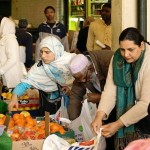Public spaces are a fundamental feature of cities and urban culture. In cities around the world, urban spaces such as plazas, markets, streets, town halls temples and urban parks have long been centres of civic life where people encounter each other, socialize, exchange goods and have face-to-face interactions. In these key public spaces there are opportunities for gathering, recreation, festivals, and trading as well as protests and demonstrations. The quality, functionality and accessibility of public spaces in a city are commonly perceived to be a measure of the quality of urban life. They can be both outdoor and indoor. Civic buildings are also key public spaces because it is in these internal spaces where the community meet, socialise and share experiences, making the buildings a part of the public realm. Key public spaces are therefore at the heart of bridging cultures as an arena for cross-cultural mixing and shared understanding. They are the vital arena for differences to be encountered and negotiated. The value of public space is in the everyday sociability that takes place. They are the spaces in which we can learn to live with others through seeing different norms and ways of behaving.
An important and commonly held view of what makes good public spaces is the degree of accessibility and freedom of expression that truly democratic, open and inclusive public spaces provide. From the days of the Greek Agora, the democratic nature of public space has shaped society and has been the site for the conduction of politics. Commonly perceived as the unit of measure for assessing the health of our democracy, it is in public spaces that we negotiate our common interests and express our differences, where we celebrate creativity and display our dissent. The term ‘public space’ refers to a place that is open and accessible to everyone, regardless of gender, culture, or socio-economic background.
There is no single definition of inclusive public space, however, commentators define four dimensions of accessibility:
- Physical access allows people to be physically present with no barriers to getting in to the space and moving in and through it regardless of age and ability
- Social access (or ‘symbolic access’) involves the presence of cues, in the form of people, design and management elements, suggesting who is and who is not welcome in the space
- ‘Visual access’ or ‘visibility’ of public spaces use symbols, or landmarks, within these spaces and provide a feeling of safety and comfort, as well as belonging
- Access to activities where public space provides a diverse and multifunctional range of activities that meets the needs of diverse cultures, genders, abilities and ages
More accessible public spaces promote sociability and the ‘circumstances’ for social encounters that bridge between cultures. The well-established Project for Public Spaces (PPS) describes good places as places that offer people many different reasons to go there. They are places where we want to ‘hangout’ for some time because the place offers us a variety of activities, experiences, and comfort. These places are clearly identifiable from a distance, easy to enter when you get closer, and simple to use. Taking this idea of ‘hangouts’ one step further, Ray Oldenburg, in his seminal book The Great Good Place: cafes, coffee shops, bookstores, bars, hair salons and other hangouts at the heart of the community, defines the core qualities of those ‘hangouts’. He calls them ‘third spaces’, or public spaces that host the regular, voluntary, informal and happily anticipated gatherings of individuals beyond the realms of home and work. He describes their qualities as:
- Being ‘neutral ground’, where individuals can come and go as they please
- Being highly inclusive, accessible and without formal criteria of membership
- Their ‘taken-for-granted-ness’ and low profile
- Being open during and outside office hours
- Being characterised by a ‘playful mood’
- Providing psychological comfort and support
- With conversation their ‘cardinal and sustaining’ activity, providing ‘political fora of great importance’
These are the types of spaces where people can enjoy the social vibrancy of urban life and seeing other people. They can also be places of retreat and relief from dense urban districts and structured everyday life. Places of retreat, such as parks, a cemetery, or footpaths that are close to water, provided opportunities for reflection. Markets and neighbourhood spaces provide the spaces for meeting friends and support networks. Both types of third places support well-being and have therapeutic functions.
But public spaces are more than just containers of human activity. They are also collective expressions of a city, as well as depositories of personal memories. Recollections of using a space when growing up, for example, could promote a sense of belonging, or prompt fond family memories. As places where important historical events tend to unfold, public spaces are imbued with important, collective meanings – both official and unofficial. People need a variety of public open spaces within a local area to meet a range of everyday needs: spaces to linger as well as spaces of transit; spaces that bring people together as well as spaces of retreat; green spaces as well as hard spaces such as streets or markets.
For Melissa Mean and Charlie Tims, authors of the report People Make Places: Growing the Public Life of Cities, public spaces act as self-organizing public services because they form ’a shared spatial resource from which experiences and value are created in ways that are not possible in our private lives alone.’ What this means is that public space is better understood not as a predetermined physical place, but as an experience created by the interaction between people and places. People need a variety of public spaces within a local area to meet. A range of places for everyday needs that reflect their lifestyle choices, value systems, and local traditions. These experiences together form the collective identity of a community. The report emphasises that the design of a public space to the highest standards providing top-quality facilities is not the most important factor in the creation of public space. In fact, it is the social benefits including the potential for well-being to be experienced that is ultimately the successful factor; it is what goes on within a space that is important. Here the value is placed on spaces that provide opportunities for different types of encounters – both casual and organised, routine or serendipitous. For Mean and Tims, they observe that public space in neighbourhoods, towns and cities is not in decline but is instead expanding. What they have found is that there are non-traditional spaces that create opportunities for association and exchange. Gatherings at the school gate, activities in community facilities, shopping malls, cafés and car boot sales are some non-traditional spaces. Mean and Tims re-define public space as any space where there are shared uses for a diverse range of activities by a range of different people regardless of appearance, or whether it is in public ownership.
In my book Bridging Cultures: the guide to social innovation in cosmopolitan cities, public space provides the panacea for improved cross-cultural sociability. However, there are commentators who believe we are asking too much of public space. Richard Sennett, for example, discerns three dominant modes in which different groups live together, each of which is deficient: conflict, assimilation and indifference. He argues that in present day cities we are sliding towards indifference as a way to cope with the presence of ‘others’ where public spaces might be shared by groups. They don’t really bring people together. He observes that public spaces are increasingly segmented spaces. They are based on self-selection and focusing on a narrow range of activities. At the same time there are concerns that open and uncontrolled public spaces, sites of ‘unpredictable encounter’, have been increasingly privatised. Public spaces have become subject to controls and surveillance, particularly in a post 9/11 world and the post-riots context. Some question the desire to live together in the first place and oppose the ‘thrown togetherness’ that characterizes cosmopolitan cities. As Jane Jacobs points out: ‘Cities are full of people with whom, from your viewpoint, or mine, or any other individual’s, a certain degree of contact is useful or enjoyable; but you do not want them in your hair.’ The challenge is how to encourage sociability whilst maintaining privacy and anonymity. Are there ways in which diverse neighbourhoods can create a shared sense of place where proximity can be negotiated? In my opinion, public spaces hold the seeds for a true sharing of society’s diversity and can nurture greater tolerance. The key is to provide functional and accessible public spaces that with light-touch choreography can provide the ideal context for transforming prejudice and indifference into trust and neighbourliness.

